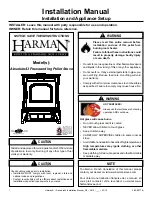
8
Intrepid
®
II Wood Burning Stove
30003840
T
ST494
steel
wall pass thru
11/00
I NT
I
P D
RE
I
I
460 mm (18") clearance all
around the pipe
Flush Mounted
Sheet Metal Cover
ST494a
Fig. 8
An approved wall pass-through.
ST245
fireplace
flex connector
12/99
Flexible Connector
Mantel Shield
Fireplace Adaptor Kit
ST245
Fig. 7
Chimney connector enters chimney through the fire
-
place opening.
Accessories are available for use as wall pass-throughs.
If using one of these, make sure it has been tested and
listed for use as a wall pass-through.
Your local dealer or your local building inspector can provide
details for other approved methods of passing a chimney
connector through a combustible wall in your area.
DO NOT CONNECT AN INTREPID II TO ANY AIR DIS-
TRIBUTION DUCT OR SYSTEM.
Hearths
This appliance must be installed on to hearth that meets
the requirements of Part J of the Building Regulations 2000
(Combustion Appliances and Fuel Storage Systems). This
can be achieved by ensuring that the hearth is constructed
and sized in accordance with the guidelines included in sec-
tion 2 of approved document ‘J’. The size and clearances
of the hearth are as follows:
The constructed hearth should be constructed in ac-
cordance with the recommendations in document J, and
should be of minimum width 840 mm and minimum depth
840 mm (if a free standing hearth b) above) or a minimum
projection of 150 mm from the jamb (if a recessed hearth
a) above).
Floor Protection for Fireplace Installations
Do not assume your fireplace hearth is completely non
-
combustible.
Many fireplace hearths do not satisfy the “completely non
-
combustible” requirement because the brick or concrete in
front of the fireplace opening is supported by heavy wood
framing as in Figure 9. Because heat passes through brick
or concrete readily, it can easily pass through to the wood.
As a result, such fireplace hearths can be a fire hazard and
are considered a combustible floor.
ST247
Rear exit floor dgrm
12/14/99 djt
Wood framing requires
protection from radiant heat
ST247a
Fig. 9
Supporting timbers under fireplace hearth are considered
to be combustible.
The following illustration shows one method of passing a
connector througha wall. All combustible material in the wall
is cut away to provide the required 460 mm (18") clearance
for the connector. The resulting space must remain empty.
A flush-mounted sheet metal cover may be used on one
side only. If covers must be used on both sides, each cover
must be mounted on noncombustible spacers at least 25
mm (1") clear of the wall.
Keep in mind that many raised hearths will extend less than
the required clearance from the front of the heater when
it is installed. In such cases, sufficient floor protection as
described above must be added in front of the hearth to
satisfy the minimum floor protector requirement from the
front of the stove: 406 mm (16") from the front. Fireplace
hearths must also offer the required protection of 152 mm
(6") on either side.






























